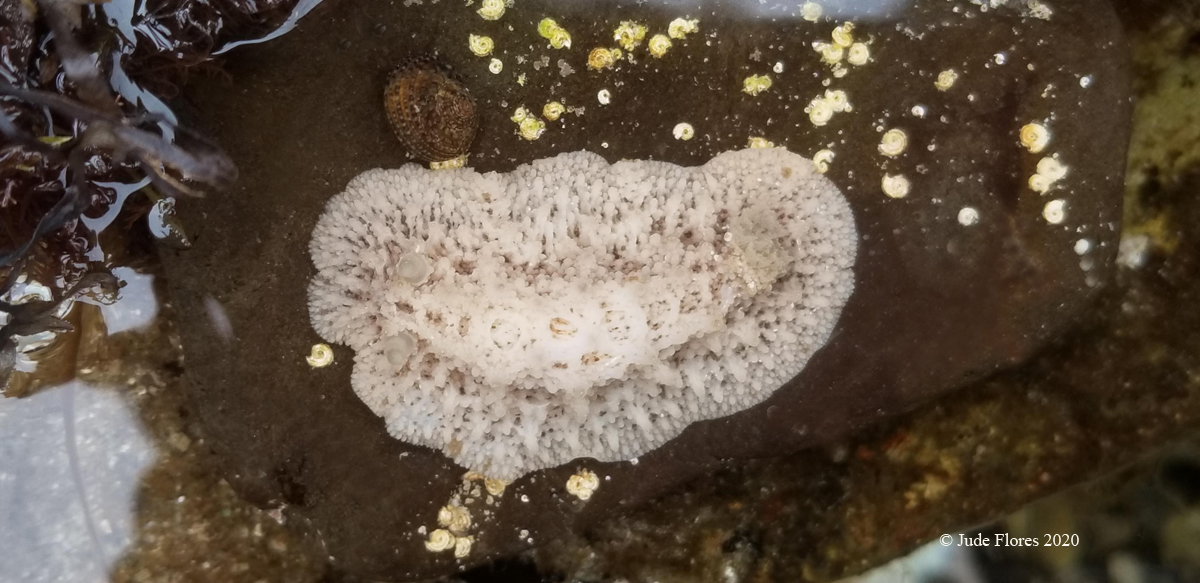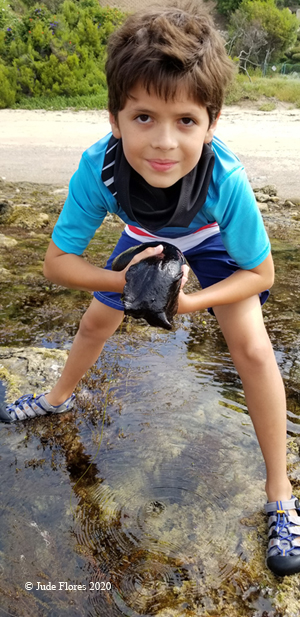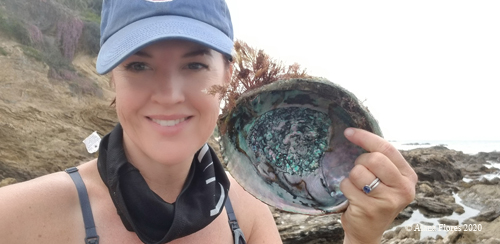 |
Image courtesy of Alana Flores
Little Corona Beach, CA
Photo taken with Samsung Galaxy Note 8
|
Jude Flores Photo courtesy of Alana Flores  |
Doris Tanya (Marcus, 1971) Well this was a fun surprise to receive. One of the rarest species living along the southern California coast was just found by a budding young slug-o-phile, Jude Flores, 10 years old of Costa Mesa, California. Personally, I have never seen this species. Hans Bertsch wrote up a BOW (85) on this species way back in 1999. Herb Gruenhagen originally sent the photo to me asking for an ID, after it had made the rounds at Scripps Institute of Oceanography and the Aquarium of the Pacific, with no takers. This is one of those species with a crazy trivial name. Describers can give a new species any name they wish of course, and that is what cat lover, Eveline du Bois-Reymond Marcus did, naming the species after a friends (Gale Sphon) cat - Tanya. Curious. The notum of this species has deep pits and irregular tubercles giving it the appearance of a sponge. It varies in color from white (seen here) to tan seen on page 72 of Eastern Pacific Nudibranchs. It is definitely an endemic species known only from a handful of specimens from The Channel Islands of California to Bahia de Banderas, Mexico, and Costa Rica. Bertsch (1981) moved Doris tanya to the genus Sclerodoris, but it has been returned to the genus Doris as it does not have caryophyllidia in the dorsal tubercles. Jude is either very lucky or has great eyes, to come across such a rare find. Good show Jude. References: Bertsch, Hans. 1981. Rectification of the generic placement of Sclerodoris tanya (Marcus, 1971), comb. nov., a nudibranch from southern California, with a range extension to the Gulf of California, Mexico. The Veliger 23 (3): 217-220. Marcus, Eveline du Bois-Reymond. 1971. On some euthyneuran gastropods from the Indian and Pacific Oceans. Proc. Malac. Soc. London 39 (5): 355-369. Dave Behrens Sammamish, WA 98074 Aug., 2020 Send Dave Behrens email at davidwbehrens@gmail.com |
Alana Flores

My sons were raised with my love for the ocean and everything in it. Jude fell in love with the abyss and then sharks when he was 5. Grey was 1. I fed his passion as much as I could. This meant going to the tidepools every 2 weeks for the low tides. It was 2015 and the winter of the El Nino. The beach was covered in tuna crabs and my boys were hooked. Their knowledge has grown exponentially and so has their curiosity. Crabs and anemones lead to urchins and sea hares which lead to octopus and nudibranchs. The most memorable experience has been finding an octopus in its den and it investigate our feet with its tentacles. The boys have also found a dead juvenile shark, dead moray eels, sea hares and sea stars that needed rescue from being stranded at high tide, abalones stuck upside down on the beach. Jude is 11 and Grey is 7. The boys now participate with a local marine biologist helping with abalone conservation doing surveys. They beam with pride when talking about it. I will say that the best part about tidepooling is being connected to the ocean, the adventures we share and never knowing what we will discover.
Send Alana and Jude mail at alanarama3@hotmail.com
|

Attention all you Sluggers, and you know who you are! The NSSI 2nd edition is now available in ebook PDF and book form . The hard back version will become available Nov. 1st. Both will cost $65 (individually). You will need to jump through a few hoops to get the electronic version as pdf distribution is protected by Adobe ID!! Please read the following to enable reading your electronic purchase! This new 2nd Edition is updated and reorganized, including 185 new species. Among other features, the new edition includes additional photographs of species, an identification key, and an up-to-date classification reflecting the latest evolutionary relationships. The Indo-Pacific represents the largest expanse of tropical ocean in the world, stretching from the Indian Ocean coast of southern Africa and the Red Sea to the central Pacific of the Hawaiian Islands, Easter Island and the Marquesas. This region supports the most diverse marine fauna of any place in the world for most groups of marine organisms. The nudibranchs and sea slugs are no exception to this rule; there are about 3,000 described species of these organisms in the world and at least 40% of these have been found exclusively in the Indo-Pacific tropics. This book illustrates 2,138 Indo-Pacific nudibranchs and sea slugs, including many undescribed species.
|

|
